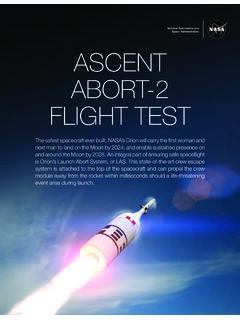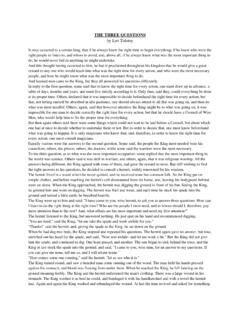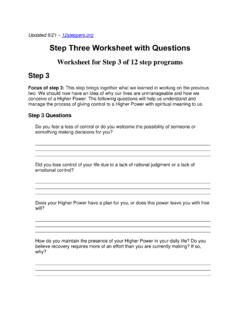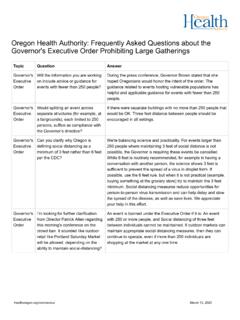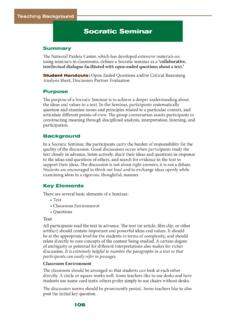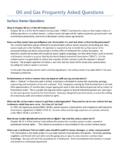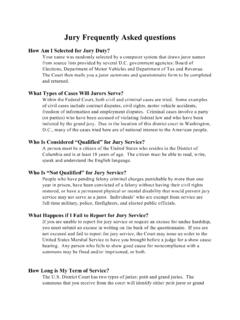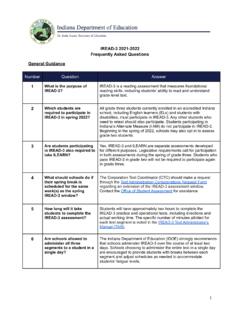Transcription of Q: What do you do on the International Space Station (ISS)?
1 Q: What do you do on the International Space Station (ISS)?A: Astronauts and cosmonauts on the Space Station stay busy. There s lots of work to operate the many science experiments on board. The crew also has to make sure that the Station is in top shape, so they clean, check equipment, maintain and repair or replace broken equipment. Crew members also must exercise two hours each day to stay fit and keep their bones and muscles strong. Sometimes we need to do a spacewalk to work outside the Station in our Space suit. It s a tough and dangerous job but the view is terrific. The extra-vehicular activities, or EVAs, help keep the Space Station : How fast and how high do you go?A: The Space Station travels through Space at 17,500 miles per hour at an altitude of about 220 miles. We orbit the Earth about once every 90 minutes. During the orbit of the Earth we are in daylight for about 45 minutes and darkness for about 45 minutes.
2 That means the sun will rise and set 16 times a day. You can see the Space Station from where you live at certain times. Visit to find out when you can see the : How long are the missions?A: The ISS missions, called expeditions, usually last about six months. There are three to six crewmembers on board at all times. Professional astronaut crews come from the , Russia, Japan, Canada and Europe. NASA astronaut Mike Lopez-Alegria has flown the longest Space Station mission to date, at 215 days. Valeri Polyakov, a Russian cosmonaut, spent 437 days in Space during one mission. A Space shuttle crew is typically five to seven crewmembers. We have carried as few as two and as many as eight at one time, and Space shuttle missions have been as short as two days and as long as 18 : What does a launch feel like?A: In a Russian Soyuz capsule, which is how astronauts who are part of expedition missions get to the Space Station , three people are crammed into a small Space .
3 The crew gets in the Soyuz about two and a half hours before launch. Once the crew is all strapped in, they perform a series of pre-flight checks of all the Soyuz systems. When the checks are finished, the crew waits while workers on the launch pad do the final rocket before the time of launch you start hearing different noises below you and you know things are getting ready to happen. Then, it is as if a giant beast is waking up. You hear and feel the thumping and bumping of valves opening and closing as engine systems are pressurized. When the first engines light there is a terrific low frequency rumbling and things start to shake. Then the main engine lights and the rumbling and shaking get even louder. Slowly, slowly you begin to move up and away from the launch pad. But, very quickly you build up speed and the g-load, or the force of gravity or acceleration on a body, increases. You shake and rattle along and then there is a bang when the rescue system is jettisoned, another bang when the four strap on boosters separate, and another bang when the nose faring comes off.
4 Now the windows are uncovered and you can see light coming in. At the second stage separation there is another bang and the g-load drops immediately. You go from about four and a half g s down to about one and a half or two g s. Then the third stage engine lights; you have a big push forward and the g-load builds and a half minutes after launch there is a loud bang and jerk and the last section of the rocket is jettisoned from the Soyuz spacecraft. And just like that, you are there in Space . It feels like you are hanging upside down in your shoulder harness. This is simply because there is nothing pushing you back into your seat anymore. Everything floats, including the Space shuttle, astronauts are strapped in on their backs a few hours before launch. As the main engines light, the whole vehicle rumbles and strains to lift off the launch pad. Seven seconds after the main engines light, the solid rocket motors ignite and this feels like a huge kick from behind.
5 The vehicle shakes a lot and the ride is rough for the first two minutes as you are pressed back into your seats with twice your weight. When the solid rocket motors burn out there is a big flash of light as they separate from the big fuel tank the shuttle is strapped to. Then the ride smoothes out. As you get higher into the thinning atmosphere and burn off most of the fuel, the vehicle accelerates faster and you are pressed back into your seat with three times your weight for the last two and a half minutes of the ride. This two and a half g s feels like a giant gorilla is sitting on your chest making it more difficult to breathe. Eight and a half total minutes after liftoff, the main engines stop and immediately you go from the being squashed by the gorilla to being weightless. Astronauts practice for launch frequently during training. We work in a simulator that mimics the noise and shaking of launch, but cannot mimic the acceleration and speed of a real launch.
6 We are busy monitoring the shuttle systems during launch, but still have time to enjoy the feeling of going from 0 miles per hour to 17,500 miles per hour in eight and a half : Where do you go in the Space Shuttle? Do you go to the moon?A: The Space Shuttle orbits the Earth at an altitude of 120-300 miles. We fly the shuttle to the ISS where we dock and continue work onboard the Station . In the past we have taken the shuttle to the Russian MIR Space Station , and we have used it to visit the Hubble Space Telescope for on-orbit repairs. Today, from our orbit above the Earth, we are in a good position to study the stars, study the Earth, perform experiments, build and resupply the ISS, and learn how to live and work in the absence of shuttle is not designed to go to the moon. It has never carried enough fuel to get to the moon and back, and, since there is no atmosphere on the moon, the wings would be of no use, and the shuttle could not land.
7 We last visited the moon with American astronauts during Apollo 17 in 1972. Currently, NASA is developing a new rocket and a new Space craft that will take people deep into Space . Q: How long do you have to train before you fly in Space ?A: Astronauts are in constant training for Space flight. The initial training involves learning about basic Space Station systems, Space walking, and operating the robotic arm. You continue this training while awaiting a mission assignment. Once assigned to a flight, specific training for your mission may take as long as three years. The length of training depends on how complicated the tasks are on your mission. ISS missions require that you speak Russian, which adds time to your : What effects does Space flight have on your body?A: A normal body will adapt to the abnormal environment of Space in many ways. Immediately upon entering zero gravity, fluids in your legs and the lower part of your body move upwards towards your head.
8 In fact, your face will feel and look swollen. Except for the occasional headache and congestion, astronauts aren t bothered by this fluid shift. Some astronauts feel dizzy and have an upset stomach during the first few days of a Space flight as they get used to zero gravity. This feeling usually goes away after three or four days. After a few days almost everyone is used to zero gravity and feels great. If you don t exercise, your bones and muscles will get weak. Upon return to FAQE arth, you must get used to gravity again. Sometimes this makes you feel dizzy or queasy. If you are returning from a two week flight, readjusting might take a day or two. If you are returning from a six month flight, it may take several weeks to feel normal : What do you do when you aren t on a mission?A: When astronauts are not flying on a mission or training for a mission, they support other missions. There are many jobs on the ground required to support the design, preparation, training and flying of a Space mission.
9 Astronauts work in mission control (the voice that communicates with astronauts in orbit), check out procedures and the checklists the crew in Space will use, help verify the Space Station and vehicle software, develop procedures and tools to be used during spacewalks or robotic operations, help scientists in developing experiments that will be run in Space and perform other jobs in support of ISS and vehicle : What kind of food do you eat?A: We bring along several different types of food when we fly in Space . Since we don t have a freezer, refrigerator, stove or microwave, most of the food has already been cooked, then freeze dried and vacuum packed (meaning the water and air has been taken out of it), or it is thermally stabilized (meaning treated and sealed in a package to prevent spoiling), much like camping food. These packages of freeze dried food can be reconstituted by adding water and then warmed up in a small warming oven.
10 We don t want food that makes crumbs in Space since crumbs would float all over the place and that could clog up equipment! Peanut butter, in fact, is the nearly perfect Space food. It has no crumbs and almost everyone loves peanut butter. We can bring fresh foods with us, as long as we eat them early in the mission before they spoil. Q: How do you go to the bathroom in Space ?A: The Space potty is a little different than the Earth potty. First of all, to keep from floating away, you must use foot-loops or straps while sitting on the seat. This holds you on to the seat, sort of like a seat belt. Secondly, the Space potty uses suction, not water, to flush. Q: Do you watch TV? What do you do for fun?A: The Space Station crews can ask mission control to send them shows that they can watch during dinner or off-duty time. They can also watch movies on their laptops. They may bring books, music, and musical instruments with them.









